Gripen E is an enhanced version of the Gripen C/D multi-role aircraft. The new fighter aircraft, whose initial delivery is scheduled for 2018, will replace the Swiss Air Force’s fleet of Northrop F-5E/F Tiger. Saab performs modifications and related construction works for Gripen E by using components supplied by Swiss companies.
Gripen C/D multi-role aircraft: Details
Saab started construction of the pre-production Gripen E test aircraft, designated as 39-8, in July 2013. Initial construction works involve assembly of the aircraft’s front fuselage, while the payload mounting works are carried out by RAUG.

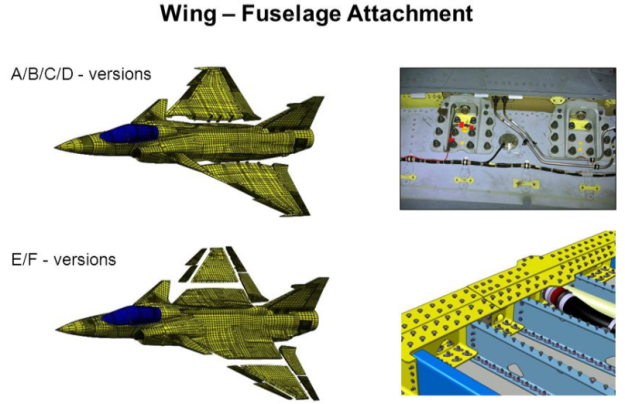 Saab
Saab
New components being integrated with the Gripen E were tested and proved in the Gripen 39-7 E/F demonstrator programme, with the test aircraft having flown for more than 250 hours in Sweden, the UK, India and Switzerland since 2008. The testing of the Gripen E is being overseen by Armasuisse.
A Gripen E aircraft fitted with new sensor IRST (Infra Red Search and Track) completed its maiden flight in April 2014. The first test aircraft was rolled out in May 2016.
Gripen E goes supersonic for the first time: Details

Excerpt
On 27 October 2017 defence and security company Saab announces that the Gripen E smart fighter flew supersonic for the first time. The aircraft broke the sound barrier over the Baltic Sea on the 18th October.
The Gripen E smart fighter flew at speeds greater than the speed of sound, at over Mach 1, as part of the ongoing flight trials programme. The purpose was to collect data from the aircraft as it achieved and sustained supersonic speed. The flight took place over the Baltic sea and the aircraft sustained supersonic speed for a number of minutes, whilst carrying out maneouvres, demonstrating the successful combination of the aicraft’s fighter design and its powerful engine.
Gripen E design details
The Gripen E has an overall length of 15.2m, wingspan of 8.6m, and maximum takeoff weight of 16,500kg. The maximum speed of the aircraft is Mach 2 at high-altitude, while the speed at low -altitude is 1,400km/h.
 gripenblogs.com
gripenblogs.com
The one seater aircraft features ten pylon stations, which enable it to carry reconnaissance pods, weapons and external fuel tanks. Its turnaround time is ten minutes in air-to-air configuration and 20 minutes, while carrying weapons for air-to-ground combat.
Pneumatic missile eject launcher pylons
Pneumatic missile eject launcher pylons are to be developed and supplied to Saab of Sweden by Excelis under a long-term agreement.
Exelis said the pneumatic missile eject launcher pylons, or PMEL, will be for use on Saab’s Gripen E fighters and allow the powered ejection of Meteor and AIM-120 advanced medium-range air-to-air missiles from the underside of the aircraft fuselage.
“This is a great opportunity for us to build on Exelis weapon carriage and release experience and continue to grow in the air-to-air missile eject market,” said Ken Harrison, vice president and general manager of International Night Vision and Communications Solutions at Exelis.
Exelis said signature of the agreement between the two companies released an immediate design and development phase contract, which includes the delivery and supply of several flight-trial units. A later initial production contract will provide for the supply of 214 PMEL units to Saab.
Work under the contract will be conducted at Exelis’ facility in Brighton, England. Source spacedaily.com
 Saab
Saab
RUAG Aerostructures pylons
 Saab
Saab
RUAG Aerostructures designs and builds the pylons for the new E/F Gripen version. Pylons are installations with which additional tanks for fuel, surveillance systems or guided weapons can be attached below the aircraft.
The individual parts of the pylon are produced using many different kinds of production procedure. The centrepiece consists of high precision milled parts of various materials. Semi-finished parts such as cast and forged components are used for this purpose. Sheathing is also produced using stretch forming processes. Welded assemblies and composite fibre components are also processed.
Eight pylons are supplied per aircraft. The final assembly of the pylons and system integration are carried out using internally developed assembly installations. Source ruag.com
 Saab
Saab
The aircraft’s internal fuel tanks with a combined capacity of 3.4t are approximately 40% larger than those of its former version. The increased volume is made possible by moving the landing gear from the fuselage of the aircraft out to the inner wings.
Saab developing two seat Gripen fighter for Brazil
April 5 (UPI) — Saab is developing its first aircraft for Brazil’s air force, the company announced during the LAAD International Defense & Security Exhibition.
The manufacturer’s work includes a two-seat version which has already begun production. Saab is coordinating with a number of Brazilian companies for the project.
“The first aircraft to be delivered to the Brazilian Air Force is already under production at Saab’s facilities in Linköping, Sweden,” Gripen Brazil business head Mikael Franzén said in a press release. “Furthermore, Brazilian engineers are participating in the development and integration of the fighter’s systems. We are seeing an excellent working relationship between the Swedes and Brazilians, with the latter very passionate about being a part of the Gripen program.”
Saab’s two-seat version of the Gripen NG is being developed in the Brazilian state of Säo Paulo. The site currently has 56 engineers working on the aircraft. Company officials say the collaboration will help Brazil’s industry improve its own capabilities.
“The transfer of technology also continues to advance to ensure the conditions needed for Brazilian companies to acquire all the knowledge related to the fighter development,” Franzén added.
The Gripen fighter is a multirole aircraft that can be armed with air-to-air and air-to-surface weapons, and can also support intelligence gathering operations.
Saab’s project for Brazil’s air force was discussed during LAAD 2017, an international defense industry conference held from April 4 to April 7. Over 600 brands are being showcased at the event. Source upi.com
Cockpit

Saab has selected AEL Sistemas (AEL) as a new supplier for the Gripen NG in Brazil. AEL will provide the wide area display (WAD) and the head-up display (HUD), which will be integrated in the Gripen NG for Brazil as part of the F-X2 contract. The WAD and HUD development programme commenced in January 2015. Saab and AEL have also signed a contract for transfer of technology.
The new avionics systems programme will run over four years and includes development, integration and production work to be performed in Porto Alegre. System integration work will be undertaken by Saab and Embraer.
The WAD for Brazil’s Gripen NG aircraft is a single intelligent and full-redundant multi-purpose display system, full-colour, large-screen (19 x 8 in) with continuous image presentation and the state-of-the-art touch-screen controls capability. It is the primary source of all flight and mission information in the cockpit.
AEL will also develop a new HUD for Brazil’s Gripen NG aircraft. The HUD provides essential flight and mission information to the pilot when looking ‘heads up’ out of the cockpit. Source saabgroup.com
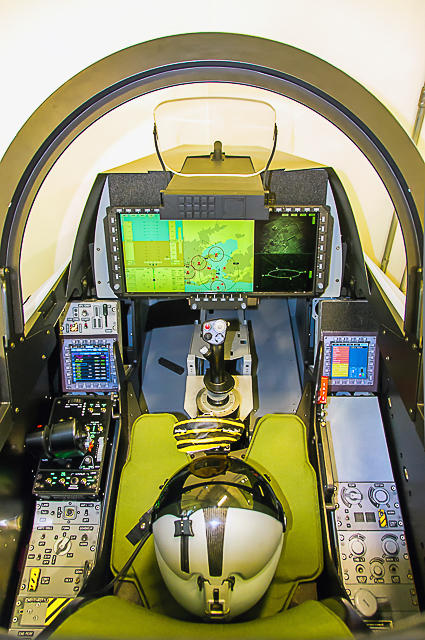 abimde.org.br
abimde.org.br
The Gripen E features a digital cockpit with three large multi-functional displays (MFD) including a few 3D screens. The cockpit also features a hands-on-throttle-and-stick (HOTAS) which provides superior situational awareness for the pilot.
AEL wide area display are offered for Saab Gripen E/F buyers
Brazilian-made wide area and head-up displays for the Saab Gripen E/F will be offered to all customers of the single-engined fighter as a potential cockpit upgrade, says Mikael Franzén, head of Business Unit, Gripen Brazil.
The Brazilian air force’s $5.4 billion order for 36 Gripen fighters includes several changes from the Swedish air force version. Instead of three multifunction displays, the FAB selected a 19in by 8in wide-area touchscreen made by AEL Sistemas, an Elbit Systems subsidiary based in Brazil.
The latest version both the wide area and head-up displays are now in safety-of-flight testing with Saab, according to AEL.
“We will make them available for all Swedish air force customers,” Franzén says.
So far, the Gripen E has only been ordered by Sweden and Brazil. The latter also has ordered eight, two-seat F-models, which Brazil is responsible for designing.
The Brazilian fighter development programme is on track to complete first flight of the single-seater in 2019, with all 36 aircraft delivered between 2021 and 2024, Franzén says. Source flightglobal.com
Mk10 seat
| Operating Ceiling | 50000+ ft (15,250m) |
| Minimum height/Speed | Zero/zero in near level attitude |
| Crew boarding mass range | 69.2 – 112.2 kg |
| Crew size range | 3rd to 99th percentile |
| Maximum Speed for ejection | 630 KIAS |
| Parachute type | GQ Type 1000 Mk 2 |
| Parachute deployment | Drogue assisted |
| Drogue parachute type | 5ft and 22 in. |
| Drogue deployment | Drogue gun. Initiated by trip rod |
| Harness type | Integrated |
| Ejection seat operation type | Ejection gun and multi-tube rocket pack |
| Ejection gun | Single, two stage |
| Gun stroke length | 72 in. |
| Ejection initiation | Handle on seat pan initiates gas operated seat firing system |
| Electronic Sequencer | No |
| Barostatic time-release unit | Yes, with 2 sec delay to give time for speed to decrease. Trip rod initiated. |
| Automatic back-up unit | No |
| Manual override handle | Yes |
| Guillotine | Yes, early variant |
| Timers | 0.50 second Drogue Gun Delay Timer, and a BTRU (barostatic time release unit) |
| Seat adjustment | Up/down Actuator operated 28 Vdc |
| Arm restraints | Yes |
| Leg restraints | Yes, two garters |
| Oxygen supply | Bottled emergency oxygen, Main oxygen system connection |
| Personal survival pack | Yes, landscale, Liferaft option available |
| Aircrew services | Personal Equipment Connector (PEC) provides connections for – main oxygen – back-up oxygen – emergency oxygen – anti-g suit – mic/tel |
| Command ejection | Yes |
| Canopy jettison | No |
| Miniature detonating cord | Yes |
| Miniature detonating cord | Yes |
| Interseat sequencing system | Yes, through command delay breech unit |
Source martin-baker.com
Targo HMD
The Swedish Defence Material Administration (FMV) awarded the airframer a SEK119 million (USD13 million) contract for an undisclosed number of systems to be delivered to the Swedish Air Force (SwAF) between 2022 and 2026. Elbit Systems’ Brazilian subsidiary AEL Sistemas (AEL) will supply the HMDs to both the SwAF and the Brazilian Air Force (Força Aérea Brasileira: FAB).
The SwAF is scheduled to receive 60 single-seat Gripen E fighters from 2019 to 2026, with the FAB taking delivery of 28 Gripen E and 8 twin-seat Gripen F aircraft from 2019 to 2024. Source janes.com
JHMCS II
- More Intelligent
- More Capable
- More Affordable
Both Digital JHMCS and JHMCS II share common design attributes that are new and improved over classic JHMCS. Both include new features and benefits that reinforce our market leadership standing.
First
JHMCS was first in the market, first in combat. And now, the JHMCS II product line is the worlds first high definition HMD using smart-visor technology that operates in both day and night mode.
Affordable
- The JHMCS II product line (both Digital JHMCS and JHMCS II) is based on the combat proven JHMCS and is now more affordable
- Both are priced to meet a broad range of market needs including reduced budget upgrades and new starts
Improved
- JHMCS II product line takes advantage of pioneering technology
- Digital image source replaces JHMCS Cathode Ray Tube (CRT)
- No high voltage requirements
- Reduced routine maintenance
- Improved center of gravity provides greater pilot comfort, especially with NVGs
- No visor trimming
- Helmet borne electronics
- Virtual HUD option
- Embedded virtual training compatible
- Pilot Health Monitoring including hypoxia and G-LOC detection and warning
- Early pilot warning and aircraft recovery option
Color
- Both versions in our product line utilize conformal color symbology to improve situational awareness
- Full color video imagery, FLIR and Picture-in-Picture
- Color de-brief camera
Advantage JHMCS
- More flight crews fly JHMCS around the world
- More crews have used JHMCS HMDs during combat operations
Additional features and benefits
- The developers of JHMCS II have worked extensively with warfighters to create a system that improves situational awareness, provides improved comfort, better balance and easy day to night mode interchange.
- With nearly 6,000 systems sold and 15 years of experience, JHMCS based products have a heritage of superior safety achievement, testing, and qualification certifications.
- JHMCS II is fully interchangeable, retrofits perfectly with all components of JHMCS and is adaptable to any aircraft architecture.
- Improvements include Flat Panel Display, Video, No High Voltage, Higher Reliability, Better Balance and higher accuracy with the new Forward Fit Opto-Inertial Tracker.
- JHMCS II Can Be Pre-ordered Now.
- JHMCS II Has The Best Warranty And Service Support In The Industry.
Source jhmcsii.com
Weapons carried on the Gripen E
 Saab
Saab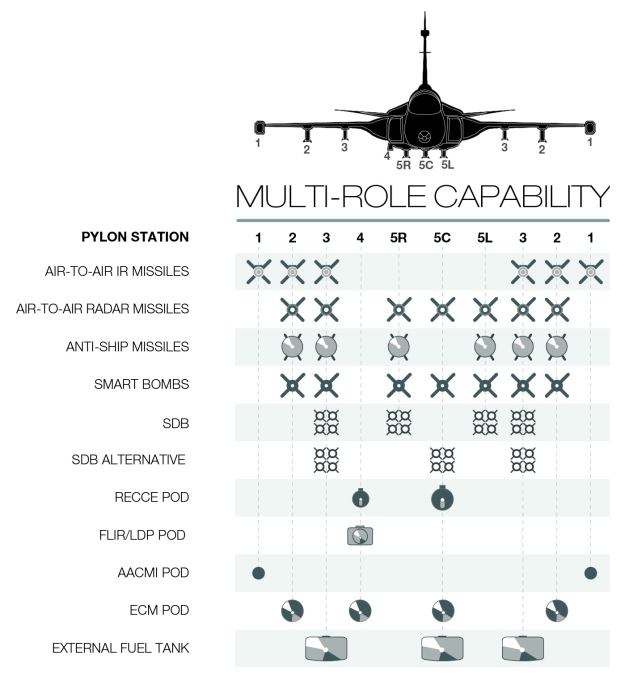
The air-to-air missiles on the Gripen E include infrared-guided short range IRIS-T missile, and the Meteor missile, which is a beyond visual range air-to-air missile (BVRAAM). The aircraft also has the flexibility to be fitted with Sidewinder and A-Darter missiles to replace the IRIS-T, and the Advanced Medium Range Air-to-Air Missile (AMRAAM) missile to replace the Meteor. It can further be fitted with long range weapons such as R-Darter and Derby, and short-range weapons such as ASRAAM and Python.
IRIS-T air-to-air missile
 IRIST-T on Gripen E – Saab
IRIST-T on Gripen E – Saab
The IRIS-T, InfraRed Imaging System – Tail/Thrust Vector Controlled, is an International initiative to replace current AIM-9L/M Sidewinder short-range, air-to-air missiles. The missile combines advanced aerodynamics and thrust vector control in a tail controlled airframe to achieve outstanding performance.
aerospace.sener
It utilizes a solid-propellant rocket motor. IRIS-T features a roll-pitch (128×128) IR seeker with �90� look angle for high off-boresight angle missile engagements. Engagements against targets in the rear hemisphere can be done successfully with the missile locked-on target after launch. IRIS-T outstanding agility is the key to successfully engage highly maneuverable advanced aircraft.
aerospace.sener
Overall, IRIS-T delivers increased agility, target acquisition range, hit accuracy, a more effective warhead and considerably improved protection against countermeasures compared with the Sidewinder missile. The mass, length, diameter and interface of the IRIS-T missile are very close to its predecessor achieving a high degree of compatibility which is a must for the IRIS-T program. During the flight tests, the IRIS-T achieved direct impact on the target even with IRCM (IR countermeasures) presence. The highly maneuverable IRIS-T missile will be integrated onto Typhoon, Gripen, F-16, Tornado, and F/A-18 aircraft. Dhiel BGT is the prime contractor for the program and Germany is the lead nation. Source deagel.com
| GENERAL DATA: | |
|---|---|
| Type: Guided Weapon | Weight: 87 kg |
| Length: 2.94 m | Span: 0.45 m |
| Diameter: 0.13 | Generation: None |
| Properties: Anti-Air Dogfight (High Off-Boresight), Capable vs Seaskimmer |
| Targets: Aircraft, Helicopter, Missile |
| SENSORS / EW: |
|---|
| IIR Seeker – (IRIS-T) Infrared Weapon Seeker, Imaging IR Max Range: 18.5 km |
| WEAPONS: |
|---|
| RB 98 IRIS-T [AIM-2000A] – (2009) Guided Weapon Air Max: 27.8 km. |
source cmano-db.com
MBDA Meteor (BVR) air-to-air missile
 Gripen E Meteor BVRAAM – Saab
Gripen E Meteor BVRAAM – Saab
Meteor is a next generation, active radar-guided, beyond visual range air-to-air missile (BVRAAM) system. The missile is being developed by MBDA Systems for six European nations.
The Meteor BVRAAM can be integrated on Eurofighter Typhoon, Saab Gripen and Dassault Rafale aircraft. The Meteor missile can also be installed on Lockheed Martin’s F-35 Lightning II Joint Strike Fighter (JSF).
The missile, being designed as a complete unit, requires no assembly and maintenance immediately before loading. This arrangement reduces its overall life logistic support cost.
Meteor can be launched as a stealth missile. It is equipped with enhanced kinematics features. It is capable of striking different types of targets simultaneously in almost any weather.
The Meteor has a length of 3.65m and diameter of 0.178m. It is designed to be compatible with AIM-120 type rail and eject launcher systems.
The Meteor missile is equipped with a blast-fragmentation warhead, supplied by TDW of Germany. The warhead is designed as a structural component of the missile. The missile integrates proximity and impact fuses.
The Meteor is equipped with a two way datalink, which allows the launch platform to provide updates on targets or re-targeting when the missile is in flight. The datalink is capable of transmitting information such as kinematic status. It also notifies target acquisition by the seeker.
The Meteor is installed with an active radar target seeker, offering high reliability in detection, tracking and classification of targets. The missile also integrates inertial measurement system (IMS) supplied by Litef.
The missile has a range in excess of 100km. It is designed for a speed greater than Mach 4. The missile has a large no escape zone.
The Meteor missile is powered by a solid fuel variable flow ducted rocket (ramjet) supplied by Bayern-Chemie. The ramjet provides the Meteor missile with a capability to maintain consistent high speeds. This ability helps the missile to chase and destroy fast moving flexible targets.
The Meteor includes an electronics and propulsion control unit (EPCU). The EPCU adjusts the rocket’s air intake and duct covers based on the cruise speed and the target’s altitude.
The EPCU observes the distance and fuel level in the rocket and adjusts the throttle of the rocket. This feature of the EPCU helps the missile to manage its fuel system. Source airforce-technology.com
 Gripen E Meteor BVRAAM – Saab
Gripen E Meteor BVRAAM – Saab
Advanced Medium Range Air-to-Air Missile (AMRAAM)
 AMRAAM – defenseworld.net
AMRAAM – defenseworld.net
The AMRAAM program improves the aerial combat capabilities of U.S. and allied aircraft to meet current and future threats of enemy air-to-air weapons. AMRAAM serves as a follow-on to the AIM-7 Sparrow missile series. The new missile is faster, smaller, and lighter, and has improved capabilities against low-altitude targets. The AIM-120 incorporates an active radar in conjunction with an inertial reference unit and microcomputer system, which makes the missile less dependent on the fire-control system of the launching aircraft. Once the missile closes in on the target, its active radar guides it to an intercept. AMRAAM-equipped fighters can attack several targets simultaneously. Deliveries of the AIM-120B version began in 1994 and ended in 1995. AIM-120C series began deliveries in 1996 and continue thru the present. Joint procurement of the AMRAAM continues with the AIM-120D version starting in fiscal 2006, which features improved navigation, kinematics, lethality and hardware and software updates to enhance its electronic protection capabilities against more capable threats.
| General Characteristics |
| Primary Function: Advanced, medium-range, air-to-air tactical missile |
| Contractor: Raytheon. |
| Date Deployed: September 1991. |
| Propulsion: Solid Propellant Rocket. |
| Length: 12 feet. |
| Diameter: 7 inches. |
| Wingspan: AIM-120A/B 21 inches; AIM-120C/D 19 inches. |
| Weight: AIM-120A/B/C-4 348 pounds; AIM-120C 5/6/7/D 356 pounds. |
| Speed: Classified |
| Platforms: Navy: F/A-18C/D/E/F Hornet and Super Hornet. Air Force: F-15, F-16 and F-22. NATO: AV-8B, Eurofighter 2000, F-1C, F-4, F-15, F-16, F/A-18, JAS-39. |
| Warhead: Blast Fragmentation; high explosive. |
Source navy.mil
A-Darter short range, air-to-air missile (SRAAM)
A-Darter, also known as V3E Agile Darter, is a fifth-generation short range, air-to-air missile (SRAAM) developed in South Africa. The AAM is designed to meet the challenges which may come from conflict against future air combat fighters.
The missile system completed several successful test launches in January 2012. It entered the final qualification phase in March 2012 and is expected to be ready for production by 2013.
The missile will enter service with the South African Air Force (SAAF) and Brazilian Air Force (FAB) in 2014.
The SAAF is planning to equip the missile on its 26 Saab Gripen fighter jets and 24 Hawk Mk120 fleet. The FAB is expected to integrate it on Northrop’s F-5E/F Tiger II, F-5A/B Freedom Fighter and future F-X2 fighters.
High explosive (HE) warhead and systems of the A-Darter SRAAM
The A-Darter is 2.98m (9.78ft) long and 0.16m (0.52ft) in diameter. It has four fixed delta control fins at the rear and two strakes along the sides. The missile weighs 90kg.
It carries a high explosive (HE) warhead and has a range of ten kilometres. It is powered by a solid propulsion system. The missile has a track rate of 120°/s and a seeker angle of 180° for countermeasure resistance. It also features lock-on after launch and memory tracking for higher range intercepts, and is compatible with Sidewinder stations.
The tail-controlled AAM is powered by a boost-sustain rocket motor and uses thrust vector flight control. Its wingless airframe and low drag enable the A-Darter to have a higher range than the traditional SRAAMs. The missile system is designed with a highly agile airframe for close combat in electronic countermeasures (ECM) environments.
It is guided by two-colour thermal imaging infrared homing with laser fuse. It features a multimode electronic counter countermeasures (ECCM) suite for higher view angles.
The SiIMU02, an inertial measurement unit (IMU) from Atlantic Inertial Systems (formerly BAE Systems), provides the mid-course guidance for the missile. Solid-state technology of the IMU provides accurate measurement of angular rate and acceleration range of up to ±9,000°/s, ±500°/s and ±500°/s in R, P and Y-axes respectively. It has a linear acceleration range of up to ±30g.
When integrated, the missile can interface with the aircraft using LAU-7 type launcher mechanical rails and MIL-STD-1760 / 1553 avionics bus system. It can be designated to a target using autonomous scan feature of the missile, helmet sight or aircraft’s radar. Source airforce-technology.com
 Gripen firing A-Darter AAM illustration – Image: Gripen blog
Gripen firing A-Darter AAM illustration – Image: Gripen blog
Technical Data
- Length : 2 980 mm
- Diameter : 166 mm
- Mass : 93 kg
Source deneldynamics.co.za
Derby missile
The Derby can be considered an enlarged version of the Python 4 missile using active radar homing instead of infrared guidance. As such the Derby is a medium sized missile. The layout is conventional with the guidance section in front, followed by the warhead and with the rocket motor making up the rear half of the missile. There are four steerable fins at the front and four small steerable wings at the rear.
The Derby uses active radar homing and can be launched at targets at short range and beyond visual range. At longer ranges the missile uses inertial navigation before the missile’s own radar acquires the target. Seeker and ECCM quality are reportedly very good.
Specifications:
Source weaponsystems.net
ASRAAM
The AIM-132 ASRAAM (Advanced Short Range Air-to-Air Missile) missile has been designed to provide excellent performance in short range air-to-air engagements. The ASRAAM has been selected by the United Kingdom and the Australian Air Force for their Tornado F3, Harrier, F/A-18 and Eurofighter-Typhoon aircraft.
The ASRAAM features an advanced IR seeker (128×128 resolution) and the capability to operate in heavy ECM environments. It receives the target coordinates from the aircraft’s sensors (radar and IRST), the pilot’s helmet mounted sight or even from its own IR imaging sensor in the search and track mode. Its high speed and maneuverability provides the ASRAAM with a high kill probability once fired. ASRAAM has a single blast fragmentation warhead detonated by impact and laser proximity fuze.
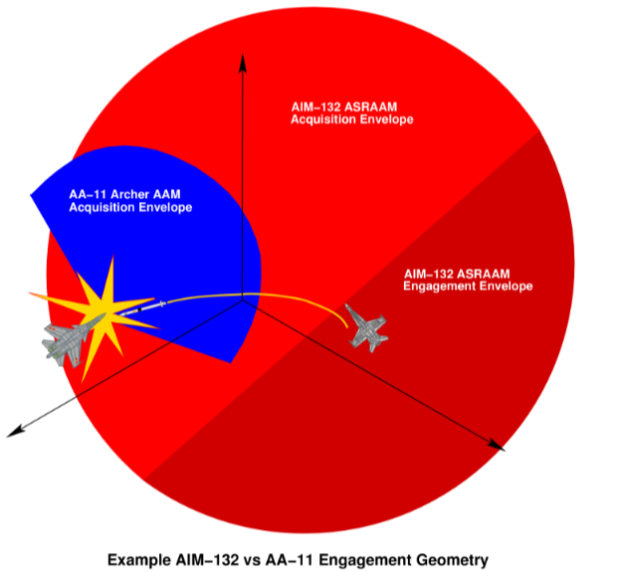 ausairpower.net
ausairpower.net
Dimensions
Diameter: 170 millimeter (6.69 inch)
Length: 2.90 meter (114 inch)
Wingspan: 450 millimeter (17.7 inch)
Performance
Max Range: 15,000 meter (8.10 nautical mile)
Min Range: 300 meter (0.16 nautical mile)
Speed
Top Speed: 996 mps (3,587 kph)
Weight
Warhead: 10 kilogram (22.0 pound)
Weight: 88 kilogram (194 pound)
Source deagel.com
The Gripen E can also be integrated with a number of air-to-surface weapons including unguided Mk82, Mk83 and Mk84 bombs, laser-guided bombs such as GBU-12, GBU-16 and GBU-10, and advanced bombs such as GBU-49 and GBU-39. Air-to-surface missiles such as RBS15F ER, TAURUS KEPD 350, AGM-65 Maverick, and MBDA’s dual-mode Brimstone (DMB) can also be integrated into the Gripen E.
GBU-10 Paveway II
The GBU-10 Paveway II consists of a MK-84 2,000 pound (1,000 kg) bomb with an added laser guidance package. This bomb is suitable against bridges, bunkers, and SCUD launchers.
Dimensions
Diameter: 460 millimeter (18.1 inch)
Length: 4.32 meter (170 inch)
Wingspan: 1.70 meter (67 inch)
Performance
CEP: 9 meter
Max Range: 14,800 meter (7.99 nautical mile)
Weight
Warhead: 429 kilogram (946 pound)
Weight: 944 kilogram (2,081 pound)
Source deagel.com
GBU-12D/B Paveway II LGB
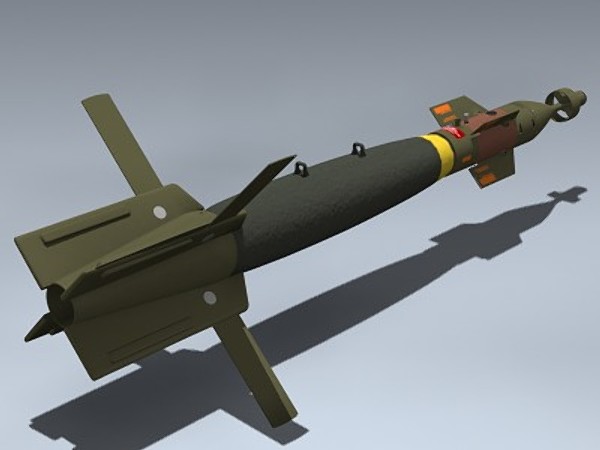
The GBU-12 Paveway II consists of a MK-82 500 pound (250 kg) bomb with an added laser guidance package. This bomb is suitable against small, hardened targets such as battle tanks and other armored vehicles. This bomb also features a reduced collateral damage probability due to its lightweight warhead.
Dimensions
Diameter: 270 millimeter (10.6 inch)
Length: 3.33 meter (131 inch)
Wingspan: 1.32 meter (52 inch)
Performance
CEP: 9 meter
Max Range: 14,800 meter (7.99 nautical mile)
Weight
Warhead: 87 kilogram (192 pound)
Weight: 277 kilogram (611 pound)
Source deagel.com
GBU-49/B Paveway II GPS/LGB
The GBU-12 Paveway II consists of a MK-82 500 pound (250 kg) bomb with an added laser guidance package. This bomb is suitable against small, hardened targets such as battle tanks and other armored vehicles. This bomb also features a reduced collateral damage probability due to its lightweight warhead.
The Enhanced Paveway II EGBU-12 is a dual-mode guided bomb designed to effectively operate in all-weather conditions. Laser-guided GBU-12s can only operate in optimal weather conditions endangers the laser beam which guides the bomb through its intended target. EGBU-12s, which were introduced in 2001 during operation Enduring Freedom in Afghanistan, relies on semi-active laser guidance and Global Positioning System (GPS) aided inertial guidance system to seamlessly hit the target. The GPS guides the bomb in poor weather conditions and laser guidance aides engaging mobile targets of opportunity.
Dimensions
Diameter: 270 millimeter (10.6 inch)
Length: 3.33 meter (131 inch)
Wingspan: 1.32 meter (52 inch)
Performance
CEP: 9 meter
Max Range: 14,800 meter (7.99 nautical mile)
Speed
Target’s Max Speed: 70 kph (0.06 mach)
Weight
Warhead: 87 kilogram (192 pound)
Weight: 277 kilogram (611 pound)
Source deagel.com
Boeing GBU-39 Small-Diameter Bomb
 Boeing GBU-39 GPS-guided 113kg (250lb) small diameter bomb
Boeing GBU-39 GPS-guided 113kg (250lb) small diameter bomb
The Laser Small Diameter Bomb (Laser SDB) system is the next generation of affordable and low-collateral-damage precision strike weapons, which builds on the success of the same Semi-active Laser (SAL) sensor currently used by Boeing’s Laser JDAM. A Laser SDB increases mission effectiveness in several ways:
By using already-proven laser sensor technology, Laser SDB offers the flexibility to prosecute targets of opportunity, including moving targets. With the BRU-61 Carriage System, these optimized munitions offer increased load-out for each weapons station to prosecute multiple targets per sortie. As a 250-lb. class weapon, Laser SDB’s smaller size and High Performance Wing Assembly allow it to glide for extended ranges.
Besides providing a safer standoff distance for pilots at greater than 60 nautical miles, Laser SDB target coordinates can be updated after weapon release by illuminating the target with standard Laser designation procedures. Laser SDB also retains a smaller warhead that provides reduced collateral damage, and offers ultra-low fragmentation with the composite focused lethality munition (FLM) variant. Source boeing.ca
GBU-39/B Weapon:
• Dimensions: (L x W): 70.8″ x 7.5″ (1.8 m x 19 cm)
• Weapon Weight: 285 pounds (130 kg)
• Warhead: 206 lb. (93 kg) penetrating blast fragmentation
• Warhead penetration: >3 feet of steel reinforced concrete
• Fuze: electronic safe/arm fuze
• Standoff maximum range: more than 60 nautical miles
• Precision inertial navigation system/GPS
• Anti-jam GPS and selective-ability anti-spoofing module
BRU-61/A Carriage System:
• Payload capacity: four weapons
• Weight: 320 pounds (145 kg) empty, 1,460 pounds (664 kg) loaded
• Dimensions (L x W x H): 143″ x 16″ x 16″ (3.6 m x 40.6 cm x 40.6 cm)
• Fits nearly all delivery platforms
| GENERAL DATA: | |
|---|---|
| Type: Guided Weapon | Weight: 129 kg |
| Length: 1.8 m | Span: 1.38 m |
| Diameter: 0.19 | Generation: None |
| Properties: Weapon – INS w/ GPS Navigation |
| Targets: Land Structure – Soft, Land Structure – Hardened, Runway |
| WEAPONS: |
|---|
| GBU-39/B SDB – (USAF, 2006) Guided Weapon Land Max: 111.1 km. |
Source cmano-db.com
Saab RBS15F ER anti-ship missile
 RBS-15 – Saab
RBS-15 – Saab
Sweden will equip its future fleet of Gripen E fighters with an extended-range version of the Saab/Diehl Defence-produced RBS15 anti-ship missile, under a project worth SKr3.2 billion ($358 million).
Announced on 31 March, the deal will deliver weapons with “greatly improved capabilities to engage any target, in all [weather] conditions”, says Saab chief executive Håkan Buskhe. Equipped with an upgraded seeker, the RBS15F ER will have a reduced launch weight and increased range compared with earlier versions of the maritime- and land-attack missile.
The extended-range design will be among a variety of weapon types to be carried by the Gripen E, which is scheduled for delivery to the Swedish air force from 2019. Others include MBDA’s Meteor beyond visual-range air-to-air missile, which entered service with its MS20 operating standard Gripen Cs last year, and Diehl Defence’s short-range IRIS-T.
Saab lists the 4.35m (14.3ft)-long, sea-skimming RBS15F ER as weighing around 600kg (1,320lb), including a 200kg warhead. It cites an operational range of more than 108nm (200km). Source flightglobal.com

RBS15 Gungnir
| Length: | 4.35 m |
| Fuselage diameter: | 0.50 m |
| Wingspan: | 1.40 m |
| Weight (in flight): | ca 650 kg |
| Weight (with boosters): | ca 810 kg |
| Seeker: | Active radar |
| Speed: | 0.9 Mach (subsonic) |
| Range: | >300 km |
| Warhead: | ~200 kg |
| Trajectory: | Multiple 3D waypoints |
| Navigation: | INS and Anti-Jam GPS |
| Service life: | 30 years |
| Launch platforms: | Aircraft, ships and trucks |
| Target set: | Manoeuvring ships at sea, stationary land targets |
Source saab.com
Taurus KEPD 350
Main features
- Designed to penetrate dense air defences
- Intended to neutralize high-value stationary and semi-stationary targets
- Day-and-night all-weather capabilities
- Only stand-off missle capable of being programmed for effect at a specific pre-selected floor
FEATURES
The TAURUS KEPD 350 is an MTCR category 2 weapon, designed to penetrate dense air defences by means of a very low level terrain following flight.
The TAURUS KEPD 350 is intended to neutralize high-value stationary and semi-stationary targets through its highly effective 481 kg dual stage warhead system MEPHISTO.
It combines outstanding penetration capabilities for hard and deeply buried targets (HDBT), as well as blast and fragmentation capabilities against high-value point and area targets (e.g. air defences), as well as an exceptional bridge- and runway-target kill capacity.
The TAURUS KEPD 350 remains the only stand-off missile capable of being programmed for effect at a specific pre-selected floor. This extraordinary feature is achieved by applying layer counting and void sensing-technology. It also has day-and-night all-weather capabilities.
TECHNICAL SPECIFICATIONS
| Range | +500 km |
| Weight | 1400 kg |
| Length | 5 m |
| Warhead | 481 kg (Tandem warheads) |
| Velocity | M 0.6-0.95 |
| Approach | Low Level Terrain Following Navigation Tre-Tec(IMU aided by Image-based Terrain Reference navigation and GPS) |
| Propulsion | Turbojet |
Source saab.com
 TAURUS KEPD 350 on both wings of Gripen – acecombat.wikia.com
TAURUS KEPD 350 on both wings of Gripen – acecombat.wikia.com
The aircraft features a 27mm all-purpose Mauser BK27 high velocity gun providing both air-to-air and air-to-surface attack capability. It is also equipped with a missile approach warning (MAW) system and is capable of carrying more chaff packets and flares compared with similar aircraft, enhancing its survivability.
27mm all-purpose Mauser BK27 high velocity gun
The revolver cannon BK 27 was developed against the stringent requirements for Nato air forces for the use in aircraft. Today, more than 3,000 BK 27 are in service all over the world, in aircraft such as the Tornado, the Alpha Jet and the Gripen. The performance assessment of aircraft cannons for the Eurofighter in the 1980s resulted in no alternative to the BK 27.
The main features of the BK 27mm are high performance, high kill probability and reliability using a broad variety of ammunition.
For the Eurofighter, the BK 27 installation introduced, for the first time for a revolver gun, a linkless-closed ammunition feed system, the Linkless Ammunition Box (LAB). Apart from eliminating the risks associated with the ejection of cases and links, such a self-contained feeding system results in a significant volume reduction of about 60%. Thus, a risk free and modular adapted weapon system is available for integration into future fighter aircraft.
The Frangible Armour Piercing (FAP) round can be deployed in both the air-to-ground and air-to-air roles.
FAPDS AMMUNITION – FRANGIBLE ARMOUR PIERCING
The “Frangible” concept was developed to defeat both “hard” and “soft” targets, without recourse to the use of conventional high explosives and fuses. Based on the well-proven Oerlikon Contraves sub-calibre technology, employing an in-situ plastic-moulded tungsten alloy core with integrated driving band, the FAPDS ammunition has a very high muzzle velocity. As a result, a flat projectile trajectory and a short flight time significantly increase the hit probability. The FAP rounds were especifically designed for aircraft cannon such as the M 39 and M 61. Source usaf.com
Gripen E’s radars, sensors and communication systems
The Gripen E features Selex’s ES-05 Raven active electronically scanned array (AESA) radar system. Fitted on a swashplate at the nose of the aircraft, the radar provides an angular field of view of 100° and look behind capability.
Selex’s ES-05 Raven active AESA radar
The Raven ES-05 is an evolution of the fire control radars of the Raven family (500E and 1000E), manufactured by Selex Galileo. Selex Galileo has the unique distinction of not only creating an array of fire control AESA radars (the Vixen E family) but also a number of AESA surveillance radars (the Seaspray E family).
The Raven ES-05 radar uses about one thousand TRMs capable of generating high-power radar beams. The radar also generates a wide array of wave and processing regimes, capable of implementing a set of air-to-air seek while tracking, combat, air-to-ground and air-to-sea modes.
An important technological innovation introduced by Selex Galileo in the Raven ES-05 was the “Swashplate” concept. The AESA radars had their antennas made up by a matrix of TRMs, in a flat circular configuration, without mechanical movement, attached to the bulkhead of the front fuselage of the aircraft. This type of radar antenna can move its electronic beam anywhere inside a field of view (FoV – Field of View) to detect and track targets.
However, the FoV of these types of AESA is limited to about +/- 60 degrees in relation to the longitudinal axis of the aircraft and its front. The Swashplate concept consists of a mounted AESA antenna inclined in a ring with electromechanical rolling. The key-component of the Swashplate is the rotating joint that transfers the cooling liquid, control and power signals and RF signals from and to the radar receiver behind the aircraft bulkhead.
The rotating joint, as it occurs with the radar units, has to occupy the smallest space possible, with minimum operating weight and reliable manner, based on the hostile operating environment on-board a fighter jet. The inclined layout of the Swashplate allows the total scanning angle of the radar to be the same as the maximum electronic angle plus the angle of inclination, that is, an angle of 45 degrees of inclination will allow a total scanning angle of 105 degrees.
In long-range air-to-air combat, the highest FoV means that a Gripen can maneuver at an angle in relation to the viewed axis of the target (off-boresight angle) greater than what is possible with an AESA radar with fixed TRMs matrix after launching a BVR missile and still be able to send updated information to the missile. In turn, a potential enemy will be limited to deviating up to 60º of the viewed angle after launching the BVR missile. Therefore, it will still be displacing towards a missile launched by Gripen while this, in turn, will be flying perpendicularly or even away from the enemy missile. Simulations made showed that this capacity should not be underestimated and it will have a devastating effect in the engagement result of the BVR.
Another advantage offered by the Swashplate is its use in recognition missions because the higher FoV enables images generated by the Raven radar operating in synthetic aperture mode (SAR) to be wider, offering greater coverage of the desired region.
An AESA radar allows its antenna to be used for digital information exchange (data linking) between aircrafts that “talk” a same communication protocol and Raven is not a exception to the rule. Therefore, it is possible for a Gripen NG to detect targets with its radar and digitally transmit the information to other Gripen NG fighter aircrafts without them using their own radars, with this increasing the stealth effect of the aircrafts and increase their probabilities of success in the combat. Hence, a single Gripen NG can operate as a “mini-AWACS”, able to detect targets and obtain SAR imaging simultaneously, and disclose this information to other aircrafts. Source gripenblogs.com
| GENERAL DATA: | |
|---|---|
| Type: Radar | Altitude Max: 0 m |
| Range Max: 222.2 km | Altitude Min: 0 m |
| Range Min: 0.6 km | Generation: Late 2010s |
| Properties: Identification Friend or Foe (IFF) [Side Info], Track While Scan (TWS), Pulse Doppler Radar (Full LDSD Capability), Active Electronically Scanned Array (AESA) |
| SENSORS / EW: |
|---|
| PS-05/A Mk4 AESA [ES-05 Raven] – Radar Role: Radar, FCR, Air-to-Air & Air-to-Surface, Medium-Range Max Range: 222.2 km |
Source cmano-db.com
The passive Infrared Search and Track (IRST) sensor system fitted to the aircraft is the Skyward G supplied by Selex. It is also mounted on the nose of the aircraft and does not emit signals. The aircraft is further fitted with a passively listening advanced electronic warfare (EW) system.
Infrared Search and Track (IRST) sensor system
Finmeccanica – Selex ES will provide new equipment to SAAB, which will equip the new Gripen E for the Swedish Air Force with 60 Skyward G-IRST (infra-red search and track), infrared search and track systems made in the Selex ES plant of Nerviano (Milan).
The Skyward-G IRST is a long-range electro-optical sensor. It is a passive system that does not emit any signals of its own when in use. It detects the heat signatures of other airborne systems but cannot be detected in return. This provides a great tactical advantage.
With the IRST a Gripen can detect and track enemy targets, including aircraft, naval vessels and ground vehicles. The system also has a significant ‘counter-stealth’ capability and, when used alone or in conjunction with Gripen’s other sensors, it can produce high-fidelity tracking information against complex targets over long ranges, well beyond visual range.
KEY FEATURES
• Passive Operation (immune to electronic detection and RF countermeasures)
• Mid or Long Wave IR
• Long range detection
• Wide scan volume
• Selectable Field Of View (FOV) (Wide – Middle – Narrow)
• Open architecture
• Air cooled
• Broad suite of field proven air-to-air, air-to-surface and navigation modes
• Detection and tracking of a high number of targets.
• Software algorithms for low false alarm rate
• Growth capability to extend the existing features, includingdual IR band detector and sensor fusion with radar Source leonardocompany.com
| GENERAL DATA: | |
|---|---|
| Type: Infrared | Altitude Max: 0 m |
| Range Max: 185.2 km | Altitude Min: 0 m |
| Range Min: 0 km | Generation: Infrared, 3rd Generation Imaging (2000s/2010s, Impr LANTIRN, Litening II/III, ATFLIR) |
| Properties: Identification Friend or Foe (IFF) [Side Info], Classification [Class Info] / Brilliant Weapon [Automatic Target Aquisition], Continous Tracking Capability [Visual] |
| SENSORS / EW: |
|---|
| Skyward-G – (Gripen-NG) Infrared Role: IRST, Imaging Infrared Seach and Track Max Range: 185.2 km |
Source cmano-db.com
3D-mapping

During 2018 and 2020, 3D mapping flight tests were performed together with Maxar. Here a camera mounted on Gripen during one of the demonstration flights.
Solving the challenge of precise positioning in a GPS-denied environment
To be able to navigate with confidence and accuracy when GPS is unavailable for a long time is a game-changing capability for a fighter pilot. It sounds like a challenge – for others. Saab have studied and tested image-based and terrain navigation techniques and now propose new technology for powerful tactical navigation capability in GPS-denied environments.
Last year, Saab performed successful flight tests with Gripen E using new algorithms providing real-time and highly accurate positioning based on image mapping, known as 3D-mapping. The tests, conducted in collaboration with Maxar, successfully proved the concept where data from on-board electro-optical sensors and geo-registration algorithms is compared with a 3D surface model database in the aircraft.

Maxar, by using satellite data is producing and delivering 3D surface detail models with high accuracy.
Odometry and terrain navigation
The use of image mapping technology of odometry has also been tested previously with good results. Here an on-board sensor observes landscape features ahead and the algorithms generate a more accurate velocity vector and assist the inertial navigation system.
Terrain navigation, in which Saab has a long history, for instance TERNAV, has also been tested previously in different demonstrations and this technology has evolved in-house with new algorithms and database-handling technologies.
Robust positioning with high accuracy
By combining these three technologies (3D-mapping, odometry and terrain navigation), the navigation system will provide the Gripen pilot with a disruptive and unique capability to operate in Global Navigation Satellite System (GNSS-)/GPS-denied environments with highly accurate positioning maintained.
“In the world of modern war fighting and amongst others its requirements for zero collateral damage a high precision and robust positioning is key. The tactical navigation technology in GNSS denied environments that Saab now start to conclude will lead to a true game-changer capability in the operational arena,” says Jonas Jakobsson, Gripen Experimental Test Pilot, Saab. Source Saab
Mode 5 M428 transponder
The systems will be used by Gripen pilots to identify other aircraft or vehicles as friendly (or potentially unfriendly) and to determine their bearing and range from the aircraft. Independent from the Gripen NG’s radar and other sensors, the system can look in a different direction, allowing the pilot to use the radar to queue-up targets for subsequent identification. Of particular note, the system’s separate antennas give it a wide, more-than 180 degree field of regard, providing operational benefits.
Each complete system consists of a transponder and an interrogator. Also included is a crypto customised in accordance with customer requirements. The transponder, which is the company’s Mode 5 M428 model, is the same being offered to the UK MoD to address NATO’s requirement for a new standard of IFF across all platforms. Source avionews.com
Gripen E next-generation electronic warfare capability
 Saab
Saab
One of the standout improvements is the Gripen E’s electronic warfare (EW) system, which takes advantage of the aircraft’s fully-digital architecture. This and the more powerful jammer-emitter capability, which is made possible by the integrated set of jamming transmitters, radar warning receivers, and the Selex AESA radar set, make for a more powerful EW profile.
“The configuration of the EW system for the Gripen E allows you to focus the jamming signal in a narrower band, so the signal itself is stronger and directed at an individual specific threat,” said one of the Gripen test pilots. The previous EW system produced a broader frequency band signal, which was designed to counter several threats at once.
The Gripen E’s new EW system uses three types of signal generators to obscure the existence of the aircraft or cause confusion about its location and/or existence so that an adversary cannot choose a proper firing solution. The three types of signal generators are Digital Radio Frequency Memory (DRFM), Doppler, and Noise. DRFM emulates the signal of the radar that makes contact with the aircraft and then mirrors it back so that it appears to the operator on the other side that the radar has encountered nothing. Source janes.com
Elisra passive airborne warning system (PAWS-2)
The Elisra passive airborne warning system (PAWS-2) has been selected for the Gripen fighter. Elbit, Elisra’s parent Israeli company, said that the system was selected “following a comprehensive in-depth evaluation and testing in various scenarios as well as in a comparative live fire test.”
The missile approach warning function on the Gripen has previously been provided by Saab itself, as part of the Swedish company’s Integrated Defensive Aids System (IDAS) that has also been installed on other combat aircraft, helicopters and airlifters. IDAS includes the MAW-300, which employs ultraviolet (UV) sensors, whereas PAWS-2 is an infrared (IR) system. Elbit said that PAWS-2 is based on years of experience and has growth potential “to cope with ever-growing future requirements expected during the life-cycle of the Gripen fighter system.”
A Saab spokesman told AIN that PAWS-2 would be the baseline fit for all future Gripens but that individual customers would be free to select and integrate alternatives. The Gripen has just been chosen by Brazil, and Saab is currently campaigning to sell the fighter to Malaysia and Switzerland, having secured an order for 60 from the Swedish air force. The Swedish aircraft will be converted from Gripen Cs that are already in service. Switzerland will get 22 new aircraft, if a nationwide referendum next year confirms the purchase. Source ainonline.com
BriteCloud Expendable Active Decoy (EAD)

In addition, Saab is also offering the BriteCloud Expendable Active Decoy (EAD) as an electronic warfare option for the Gripen E.
BriteCloud is a self-contained digital radio frequency memory (DRFM) jammer that is designed to protect fighter jets from complex threats such as RF-guided missiles and fire-control radars. After manual or automatic ejection from a standard chaff and flare dispenser, BriteCloud detects RF emissions and cross-references them against its pre-programmed threat library. Upon finding a match, the decoy applies advanced algorithms and emits a deception signal to defeat the threat radar and incoming missile so that the aircraft is able to carry on safely and concentrate on its mission. Source defense-update.com
Technical Specifications
- Frequency Band H-J
- Shelf Life 5 years minimum
- Size 55mm format available now. 218 format available in 2016
- Weight 1.1kg when loaded in flare tube
Details PDF: Here
Rafael’s Litening III Laser Designation Pod (LDP) is fitted to the aircraft for attacking ground targets using laser-guided bombs. The LDP also integrates a forward looking infrared (FLIR) sensor and a charge-coupled device (CCD) camera.
Rafael’s Litening III Laser Designation Pod (LDP)
 Rafael’s Litening III Laser Designation Pod (LDP) on Gripen 39C
Rafael’s Litening III Laser Designation Pod (LDP) on Gripen 39C
Litening Airborne Day/Night Navigation & Targeting Pod provides precision strike capability to every fighter aircraft.
- reduces pilot workload during the process of targeting maintenance target
- Sighting system of high accuracy and reliability
- reduces operational limitations
- simple maintenance and support
- low maintenance cost
- potential upgrade
- upgrades available for aircraft with multi-mission capability
- Adaptable on most aircraft
- detection, recognition, identification, laser designation of targets on land or sea
- Release accurate ammunition laser-guided enema and general purpose weapons.
- identification of air targets beyond visual range (BRV)
- option for data link and long-range video

The evolution of the Litening pod continued with the Litening III version, which utilized a more capable Gen III (3-5micron) FLIR, with a 640×480 digital detectors array. This system is also equipped with a target marker, which improves the coordination of ground and air forces, by designation of targets by day or night. Litening III system is also equipped with a dual-wavelength diode-pumped laser, which is compatible with training (eyesafe) and wartime operational modes. The system also employs electronic image stabilization, to provide cleaner images of targets, acquired at long standoff range.
Logistically, the integration of the pod is easy and straightforward; it can fit the centerline or E/O pod mounts available with most modern aircraft and require no structural changes in the aircraft. Pods can also be installed on different aircraft, in support of specific missions. For example, the US Reserves currently field eight pods per wing. The pod requires minimal maintenance and technical support on the flight line. It is self boresighting in flight, therefore requires no alignment prior to the mission and improved accuracy during operations.

The Israeli targeting pod was procured by 14 air forces, including the US Air Force Reserve’s and Air National Guards for their F-16 Block 25/30/32 Fighting Falcon. Other air forces operating the system include the US Marine Corps (AV-8B), Israeli air Force (F-16), Spanish and Italian Navy (AV-8B) and Spanish air force (F/A-18), German Air Force (Tornado IDS), and the Venezuela (F-16A/B). The pods were also selected for South Africa’s Grippens, India’s Mirage 2000, MiG-27 and Jaguar. The most recent inquiry for the pods came in March, for a planned procurement of F-16s by Austria. The pod is also fully integrated in the Eurofighter, F-5E, MiG-21 and other types. Testing are underway to integrate the pod with Boeing F-15I operated by the Israel Air Force.
| Litening III specifications: | |
| length: | 220 cm |
| diameter: | 406 mm |
| total weight: | 440 lb |
| Operating altitude: | +40,000 |
| IR sensor: | 640×480 FPA Mid-IR wavelength |
| Day sensor: | CCDTV |
| Wide FOV: | 18.4 x 24.1 |
| medium FOV: | 3.5×3.5 |
| Narrow field of view: | 1×1 |
| Field of regard: | +45 / -150 |
| Roll: | +/- 400 |
| Laser: | Diode pumped laser designator, dual wavelength |
Source military.rootsweb.ancestry.com
RecceLite reconnaissande pod
 Close-up photo of RecceLite reconnaissande pod mounted on JAS 39D
Close-up photo of RecceLite reconnaissande pod mounted on JAS 39D
The RecceLite is a self-contained self-cooled multi-sensor tactical reconnaissance system, consisting of an airborne pod based on the Litening Targeting and Navigation Pod and a ground exploitation station.
The RecceLite simultaneously collects Infra-Red (IR) and Visual (VIS and near IR) digital images within a very wide field of regard, in accordance with an automatic mission plan and/or manual operation. The images and the data annotation are recorded on a solid state recorder and transmitted to the exploitation station via the RecceLite data link. The Images are then interpreted at the ground exploitation station. Source virtualmarket.ila-berlin.de
Thales Digital Joint Reconnaissance Pod
 Thales Digital Joint Reconnaissance Pod Seen here on JAS 39C – Image: saairforce.co.za
Thales Digital Joint Reconnaissance Pod Seen here on JAS 39C – Image: saairforce.co.za
Digital joint reconnaissance pod
- Pod mounted high resolution EO imagery and horizon-to-horizon IR coverage
- High speed/high altitude image collection, fulfilling all air tactical IMINT tasks
- Vertical, oblique & stand-off for reconnaissance, border patrol, BDA, foliage penetration, route clearance
- Flight envelope compatible with 4th Gen aircraft, MUAV and commercial aircraft
Source Thales
The aircraft can be fitted with regular radios, Havequick/SATURN frequency hopping secure radio, long-distance satellite communication systems, including the Link 16 for wide-area command and control (C2), which is compatible with FLORAKO radar system.
It is also fitted with a ground data link called ROVER, which provides communication to a Forward Air Controller (FAC) or Joint Terminal Attack Controller (JTAC) on the ground.
GE F414G engine for Gripen E
 The General Electric GE-414G turbofan engine undergoing static tests. Developing up to 22,000 pounds of thrust, this engine takes the Gripen E to supersonic without the use of afterburner. – SAAB
The General Electric GE-414G turbofan engine undergoing static tests. Developing up to 22,000 pounds of thrust, this engine takes the Gripen E to supersonic without the use of afterburner. – SAAB
The Gripen E is driven by General Electric’s (GE) F414G turbofan engine rated at 22,000lb (98kN). It features a new high-pressure turbine and a new six-stage, high-pressure compressor.
General Electric’s (GE) F414G turbofan engine
Source GE

Saab do Brasil
GE was awarded a $250m contract by the Government of Switzerland in December 2011 to supply the engines for the Gripen E. The aircraft’s engine and design enable it to fly at supersonic speed without using an afterburner, saving more fuel and enabling it to stay in the air longer.
APU
Gripen E orders and deliveries
 gripenblogs.com
gripenblogs.com
Orders for the new generation aircraft for Sweden are based on the initial agreements signed between Saab and Swedish Defence Materiel Administration (FMV) in February and March 2012. The agreement calls for the modification of 60 Gripen C aircraft to Gripen E configuration for Sweden from 2013 to 2026. Three development orders under the agreement have been made by 2013.
The total value of the orders under the agreement is estimated to be SEK47.2bn ($7.4bn).A framework agreement was signed in August 2012 between the Swedish Defence and Security Export Agency (FXM) and Armasuisse. Switzerland has an option to procure 22 Gripen E aircraft to be delivered between 2018 and 2021 under the agreement.
Both chambers of the Swiss Parliament,National Council (Nationalrat) and Council of States (Ständerat), won majority approvals from its members for the procurement of Gripen E in August 2013 and September 2013, respectively. In December 2014, FMV placed a $50m development order with Saab for Gripen E aircraft.
Saab received an approximately $800m order from FMV to provide role equipment, support and maintenance equipment for Gripen E aircraft, in October 2014.
Technical Specifications
Gripen E
| Length over all | 15.2 meters |
| Width over all | 8.6 meters |
| Maximum take off weight | 16500 kg |
| Max thrust | 98 kN |
| Hardpoints | 10 |
| Maximum speed | Mach 2 |
| Combat turnaround air-to-air | 10 minutes |
Gripen F (two-seater)
| Length over all | 15.9 meters |
| Width over all | 8.6 meters |
| Max thrust | 98 kN |
| Hardpoints | 10 |
| Maximum speed | Mach 2 |
| Combat turnaround air-to-air | 10 minutes |
Technical Specifications Saab
Main material source airforce-technology.com
Images are from Jaime Hunter
Revised Nov 27, 2018
Updated Nov 29, 2021





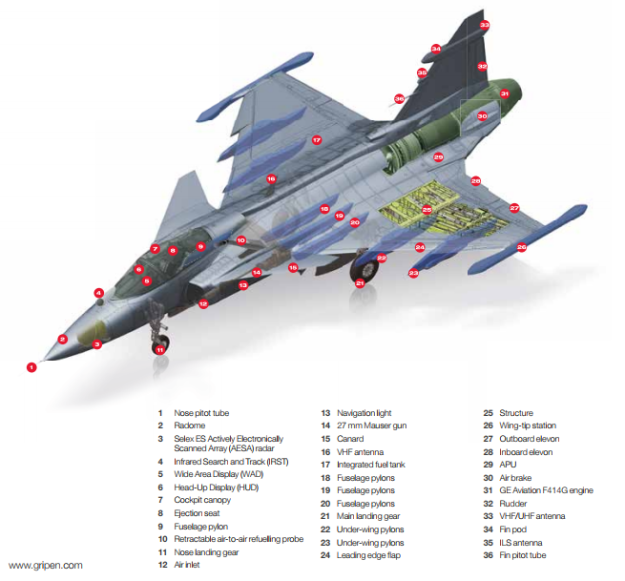






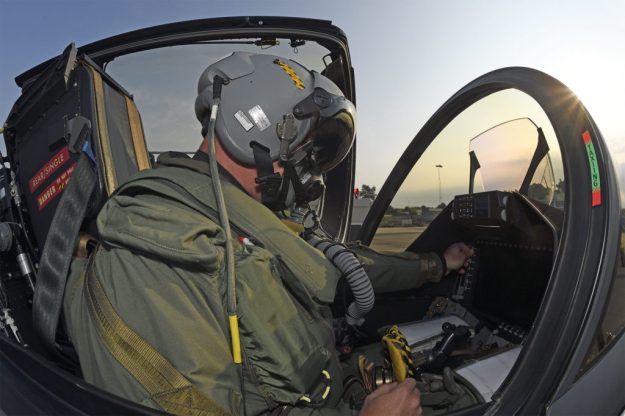






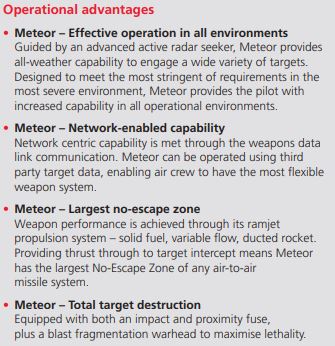




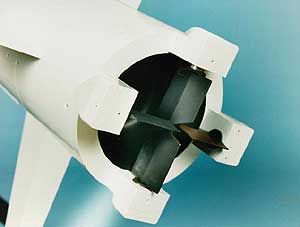















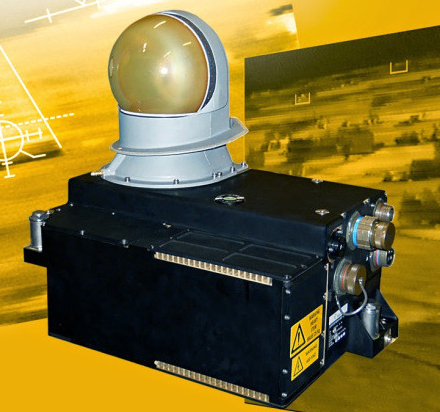














Remove all mentions of Switzerland
(Selected Gripen, but was voted down by public)
LikeLike